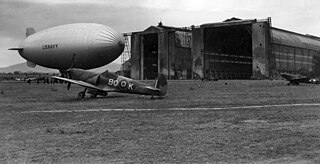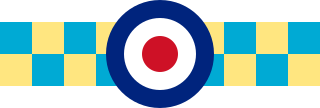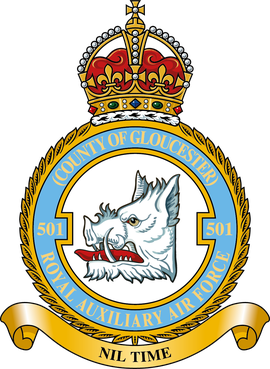
The Hawker Typhoon is a British single-seat fighter-bomber, produced by Hawker Aircraft. It was intended to be a medium-high altitude interceptor, as a replacement for the Hawker Hurricane, but several design problems were encountered and it never completely satisfied this requirement.

Number 6 Squadron of the Royal Air Force operates the Eurofighter Typhoon FGR.4 at RAF Lossiemouth. It was previously equipped with the SEPECAT Jaguar GR.3 in the close air support and tactical reconnaissance roles, and was posted to RAF Coltishall, Norfolk until April 2006, moving to RAF Coningsby until disbanding for the first time in its history on 31 May 2007. The squadron officially reformed as a Typhoon squadron on 6 September 2010. No. 6 Squadron is unique in having two Royal standards, having been awarded its second one by King Abdullah I of Jordan in October 1950 due to its long period of service in the Middle East.

No. 331 Squadron RAF was a Second World War squadron of the Royal Air Force. The squadron was primarily manned with Norwegian aircrew. The squadron was part of Fighter Command between 1941 and March 1944 when it joined the 2nd Tactical Air Force until the end of the war. The squadron took part in the Dieppe Raid and the Normandy landings.

No. 451 Squadron was a Royal Australian Air Force army cooperation and fighter squadron of World War II. It was formed at Bankstown, New South Wales, on 12 February 1941 and began flying operations on 1 July as part of the North African Campaign in Egypt and Libya. No. 451 Squadron was withdrawn for refitting in early January 1942 and spent the remainder of the year performing garrison duties in Syria. In January 1943, it was transferred to Egypt to contribute to local air defence but saw almost no combat. This inactivity caused morale among the squadron's personnel to greatly deteriorate.

No. 245 Squadron was a squadron of the Royal Air Force. It flew as an anti-submarine squadron during World War I and as a fighter squadron during World War II. After the war it was first a jet-fighter squadron and its last role was as a radar-calibration unit.

No. 607 Squadron is an auxiliary squadron of the Royal Air Force. It was formed in 1930 as a bomber unit in the Auxiliary Air Force and changed in 1936 to the fighter role. It fought in that role during the Second World War in Europe and Asia. After the war, in 1946, the squadron reformed as a fighter unit. Awarded the title Royal Auxiliary Air Force by King George in 1947, 607 Sqn was disbanded with all the other flying units of the RAuxAF on 10 March 1957. It reformed on 5 January 2015, as a General Service Support Squadron (GSS).

No 263 Squadron was a Royal Air Force fighter squadron formed in Italy towards the end of the First World War. After being disbanded in 1919 it was reformed in 1939 flying mainly strike and heavy fighter aircraft until becoming No 1 Squadron in 1958.

No. 164 (Argentine–British) Squadron was a fighter squadron of the Royal Air Force raised for service during the Second World War. It was a donation squadron, paid for by the British community living in Argentina. It operated mostly in a ground attack role, particularly during the Allied invasion of France and the subsequent advance in the Low Countries and Germany.

No. 501 Squadron was the 14th of the 21 flying units in the Royal Auxiliary Air Force, the volunteer reserve part of the British Royal Air Force. The squadron won seven battle honours, flying Hurricane, Spitfire and Tempest fighter aircraft during World War II, and was one of the most heavily engaged units in RAF Fighter Command. In particular, the Squadron saw extensive action during the Battle of France and Battle of Britain. At present the unit is not flying any more and has a logistics role as part of No 85 Expeditionary Logistics Wing.

Royal Air Force Fairwood Common, or more simply RAF Fairwood Common, is a former Royal Air Force Sector Station located on Fairwood Common, on the Gower Peninsula, to the west of Swansea. It is now the location of Swansea Airport.

No. 239 Squadron RAF was an anti-submarine squadron of the Royal Air Force during World War I. During World War II the squadron performed as an army co-operation squadron and later as a night intruder unit. After the war the squadron was disbanded.
The 336th Bomber Squadron, callsign "Olympus", is the second oldest squadron in service with the Hellenic Air Force, forming part of the 116th Combat Wing. It is based at Araxos Air Base in the Peloponnese, and operates the F-16 Block 52 Advanced aircraft.
No. 198 Squadron was a Royal Air Force aircraft squadron that operated during the Second World War particularly in the ground attack role as the allies advanced through continental Europe.
No. 268 Squadron RAF was a Royal Air Force squadron raised during the First World War and in the Second World War operated the North American P-51 Mustang on tactical reconnaissance missions over occupied Europe and in support of the D-Day landings.

443 Maritime Helicopter Squadron is a Canadian Armed Forces helicopter squadron under the Royal Canadian Air Force (RCAF), located on Vancouver Island, British Columbia. It was originally a Second World War RCAF squadron that operated as part of RAF Fighter Command in Europe with the Supermarine Spitfire.

No. 351 Squadron RAF was a Yugoslav Partisan-manned fighter-bomber squadron of the Royal Air Force (RAF) which was operational between 13 October 1944 and 1 May 1945 during World War II. The squadron was also known by the Partisans as Second Squadron (NOVJ).
No. 137 Squadron RAF existed briefly as a day bomber unit in World War I but never became operational. During World War II it flew as one of the two Whirlwind squadrons before converting to Hurricane Mk.IV fighter-bombers and later the Hawker Typhoon in the same role. The squadron was disbanded in August 1945.
No. 174 (Mauritius) Squadron RAF was a Royal Air Force Squadron that was a fighter-bomber unit in World War II.

787 Naval Air Squadron was a Naval Air Squadron of the Royal Navy's Fleet Air Arm which disbanded in January 1956. It formed in March 1941, at HMS Heron, RNAS Yeovilton, out of 804 Naval Air Squadron as a Fleet Fighter Development Unit. Almost every type of fighter was received by the squadron for testing and evaluation for naval use. A move to RAF Duxford in June 1941 saw it become the Naval Air Fighting Development Unit, attached to the Royal Air Force's Air Fighting Development Unit. The squadron undertook rocket projectile test, continuous development of fighter tactics and even helping Torpedo Bomber Reconnaissance squadrons in evading fighter attack. Post Second World War it continued its trials task and also undertook Rebecca radar trials and ASH, US-built air-to-surface vessel radar trials.

In late 1937, the Royal Yugoslav Air Force placed an order with Hawker Aircraft for twelve Hawker Hurricane Mk I fighters, the first foreign purchase of the aircraft. The VVKJ operated the British Hawker Hurricane Mk I from 1938 to 1941. Between 1938 and 1940, the VVKJ obtained 24 Hurricane Mk Is from early production batches, marking the first foreign sale of the aircraft. Twenty additional aircraft were built by Zmaj under licence in Yugoslavia. When the country was drawn into World War II by the German-led Axis invasion of April 1941, a total of 41 Hurricane Mk I's were in service as fighters. They achieved some successes against Luftwaffe aircraft, but all Yugoslav Hurricanes were destroyed or captured during the 11-day invasion.















